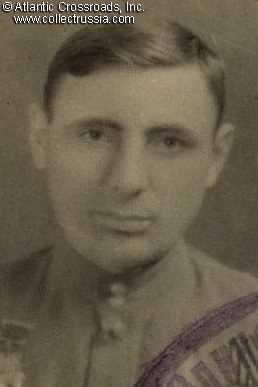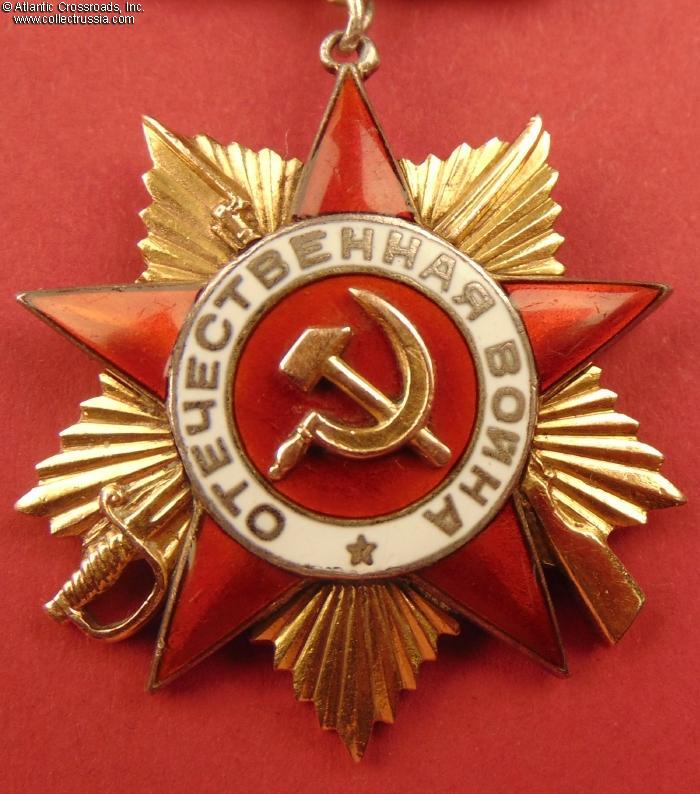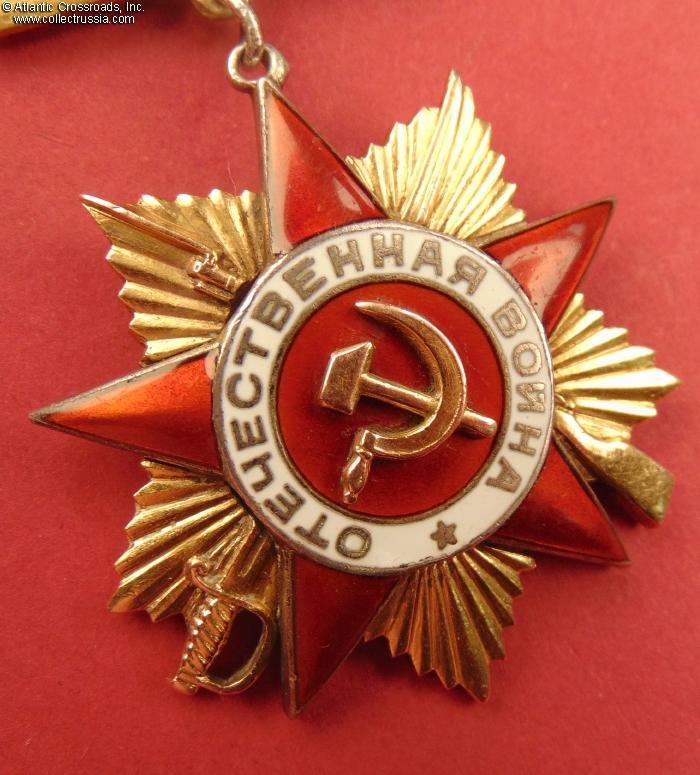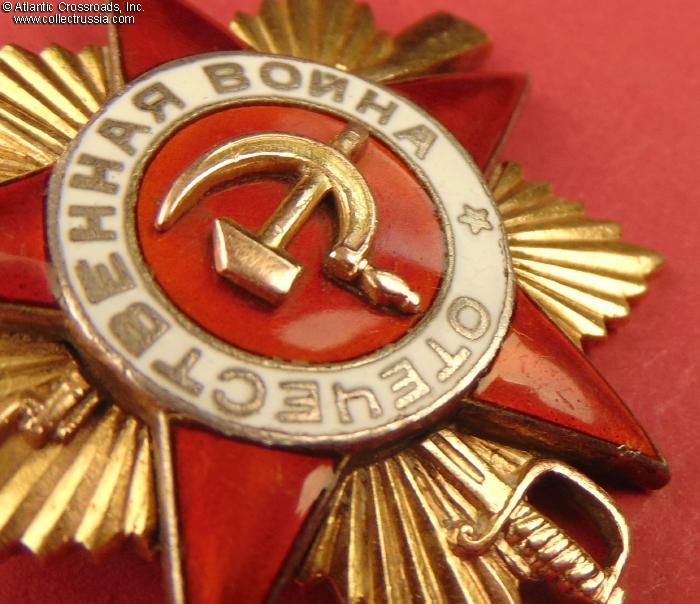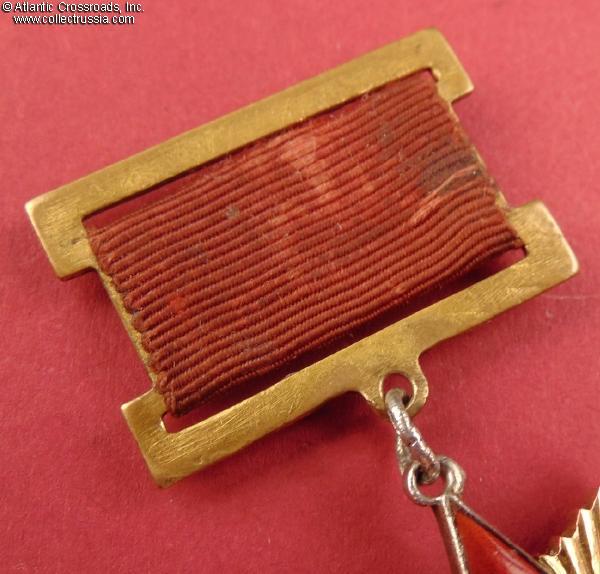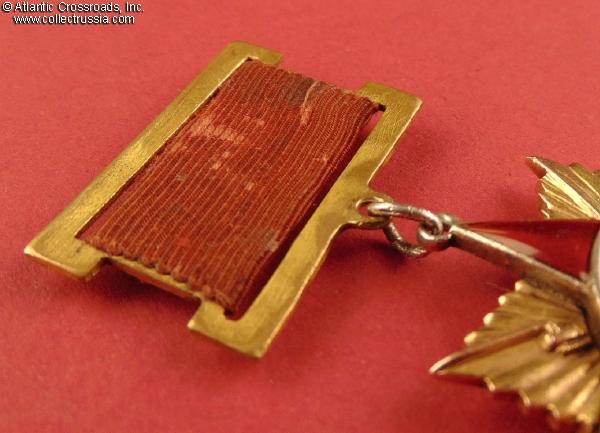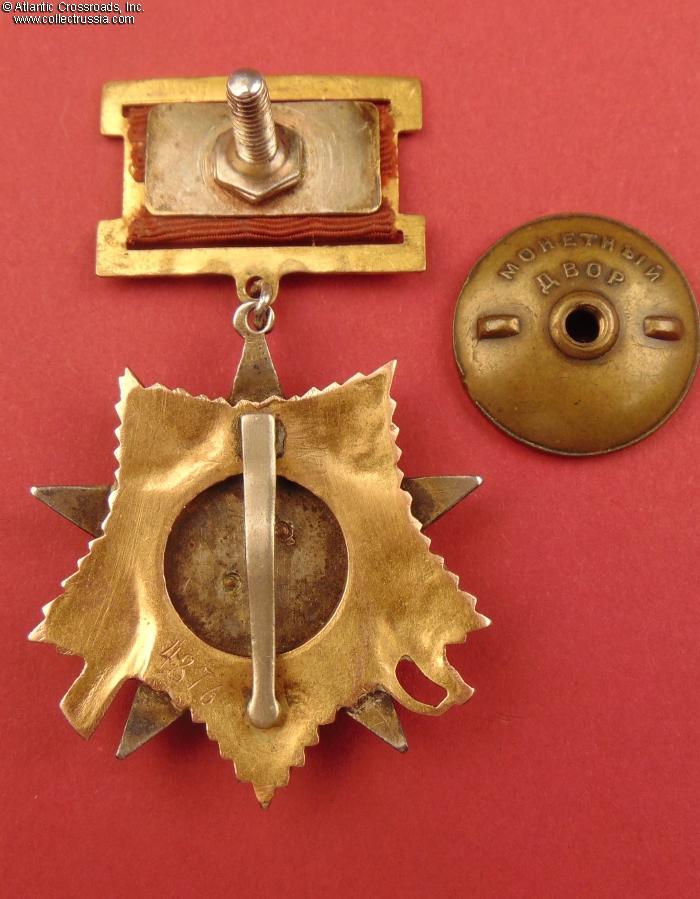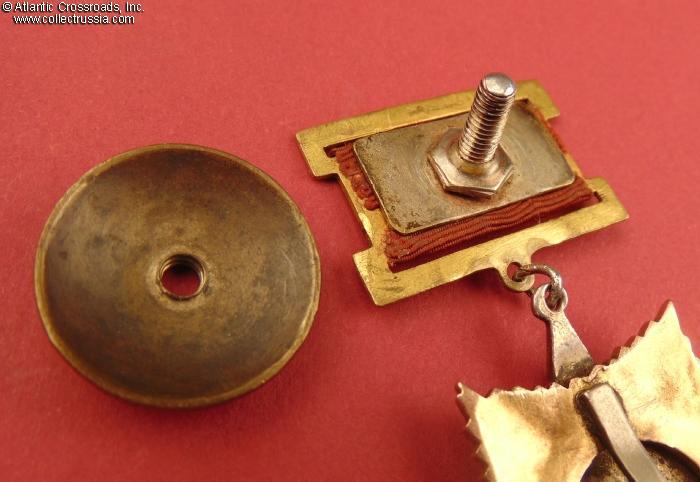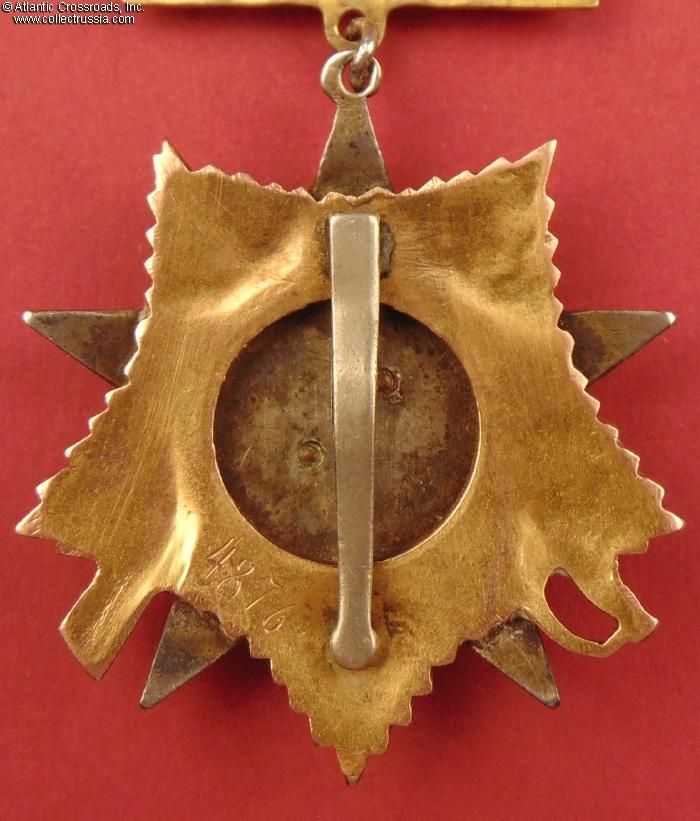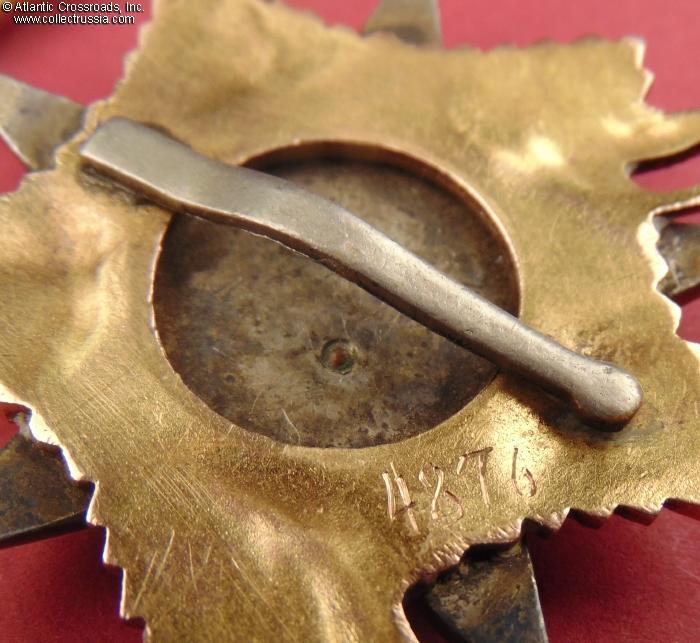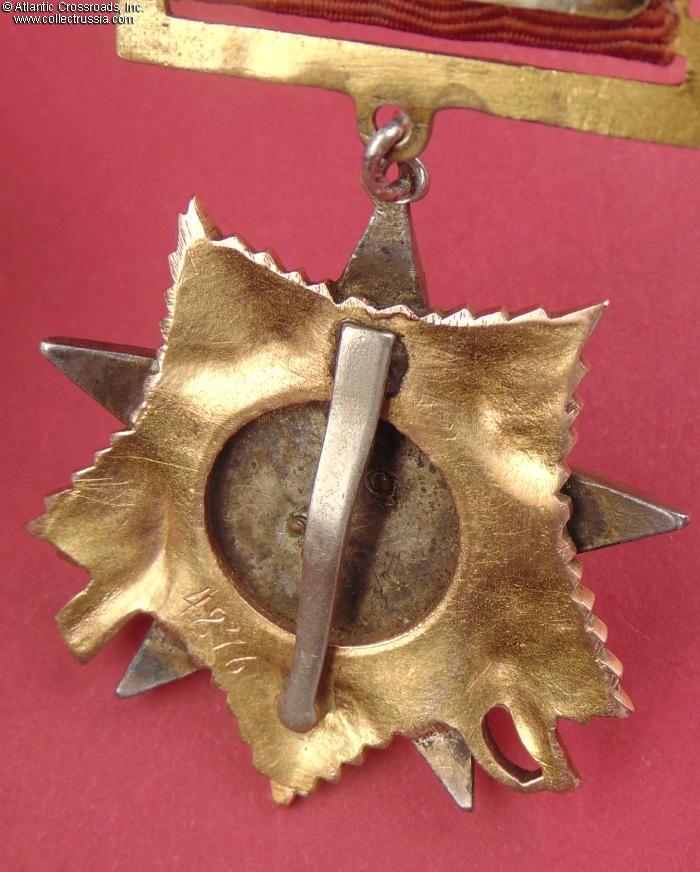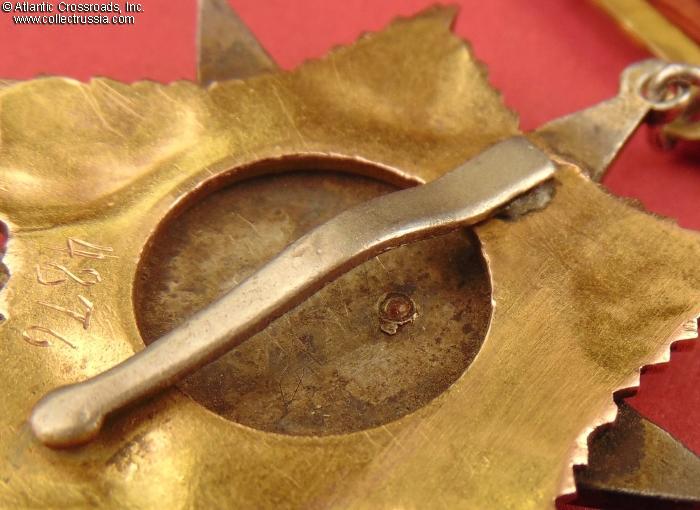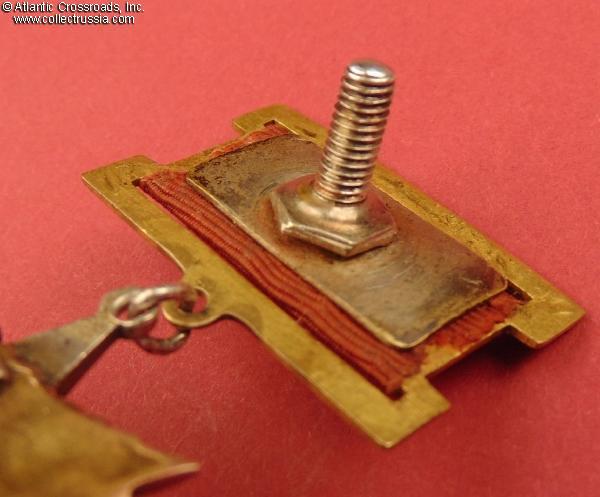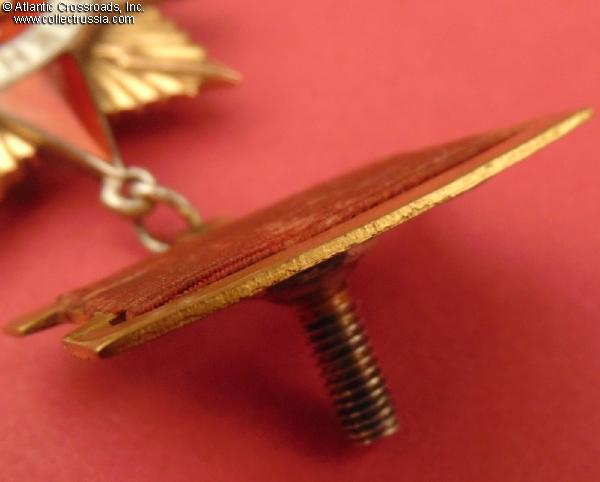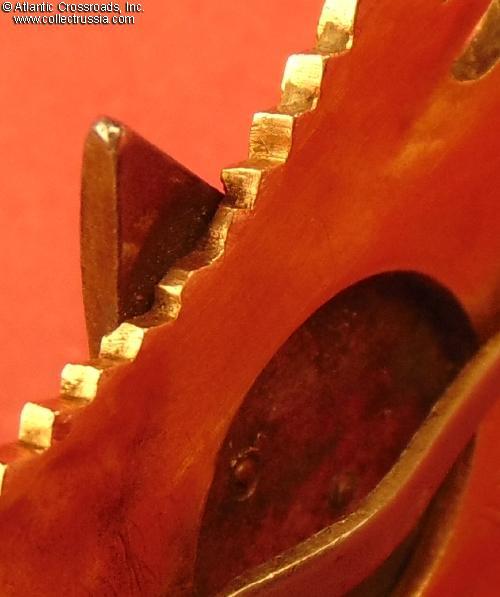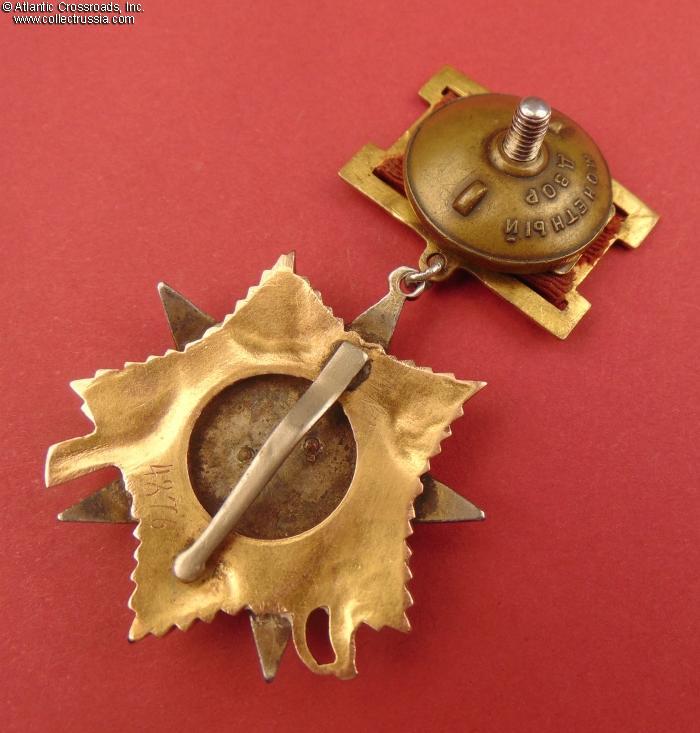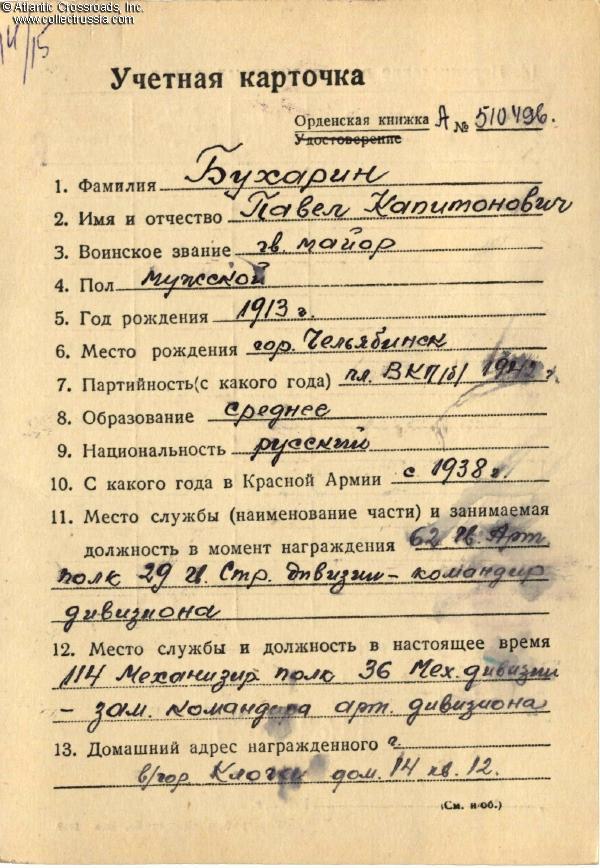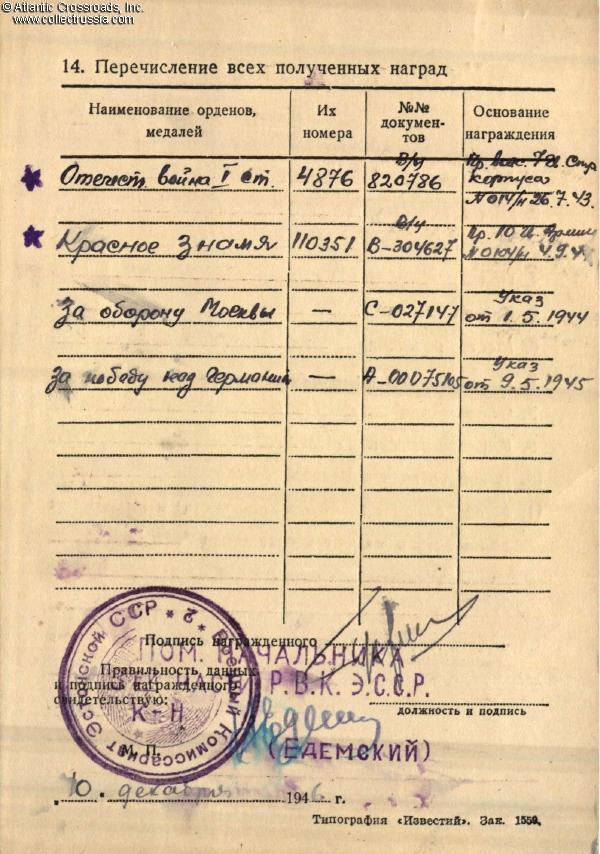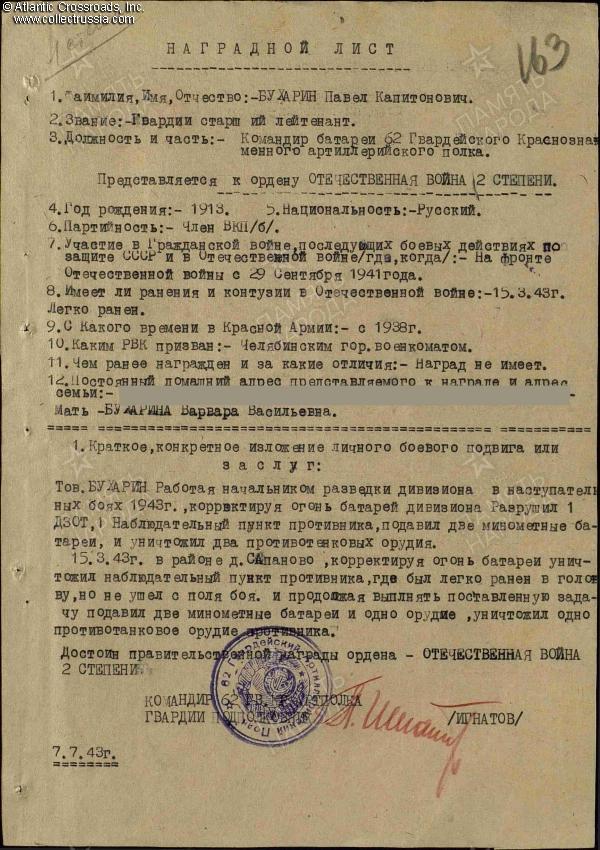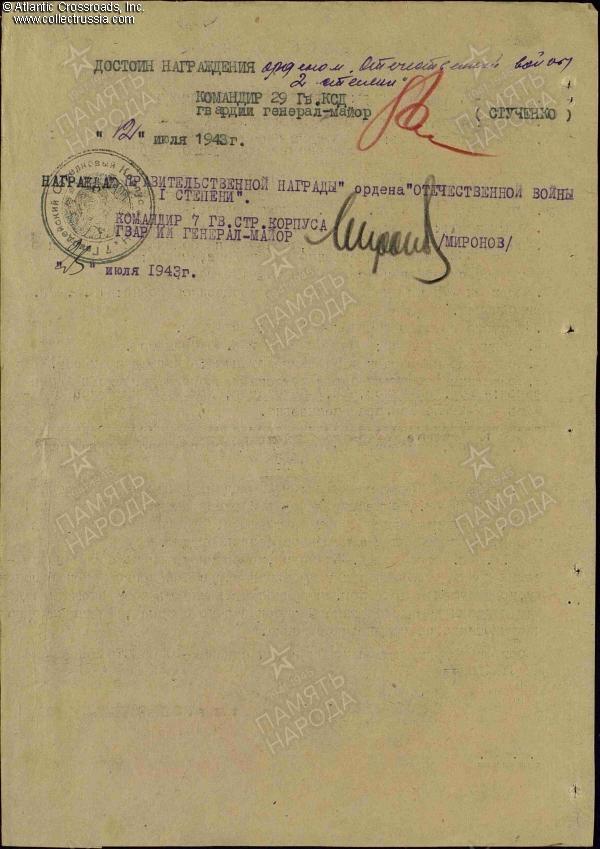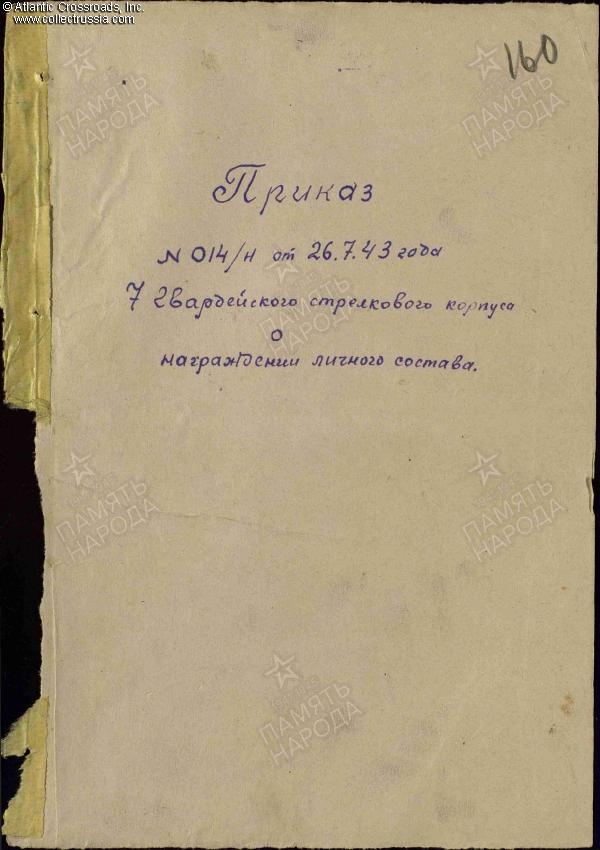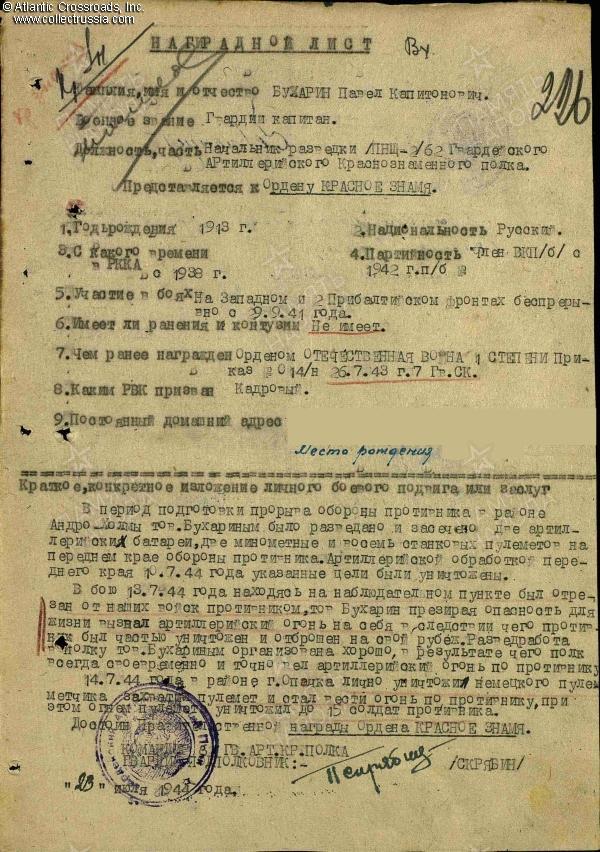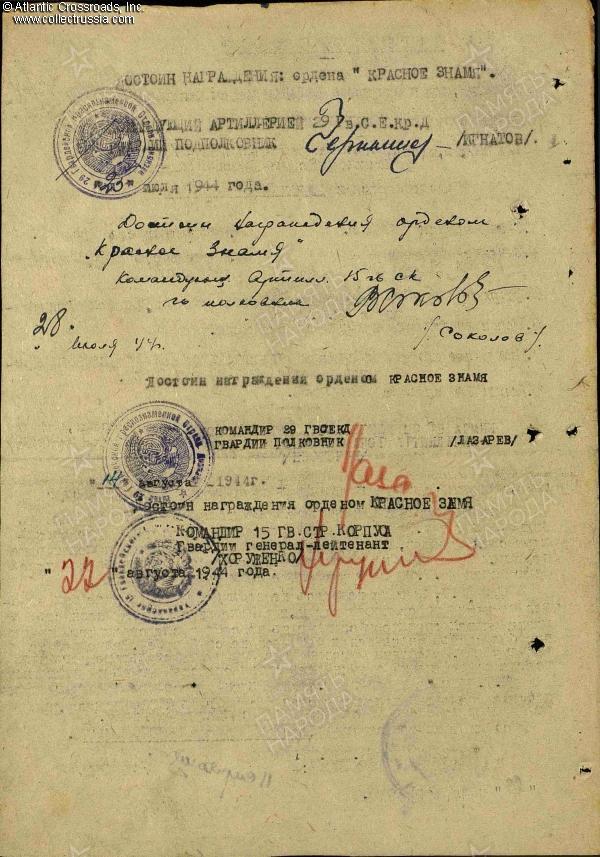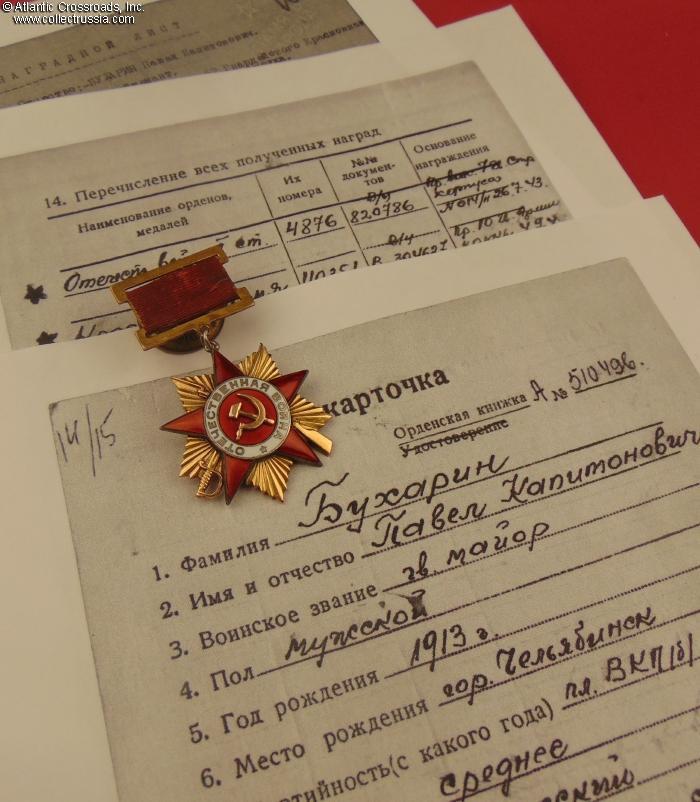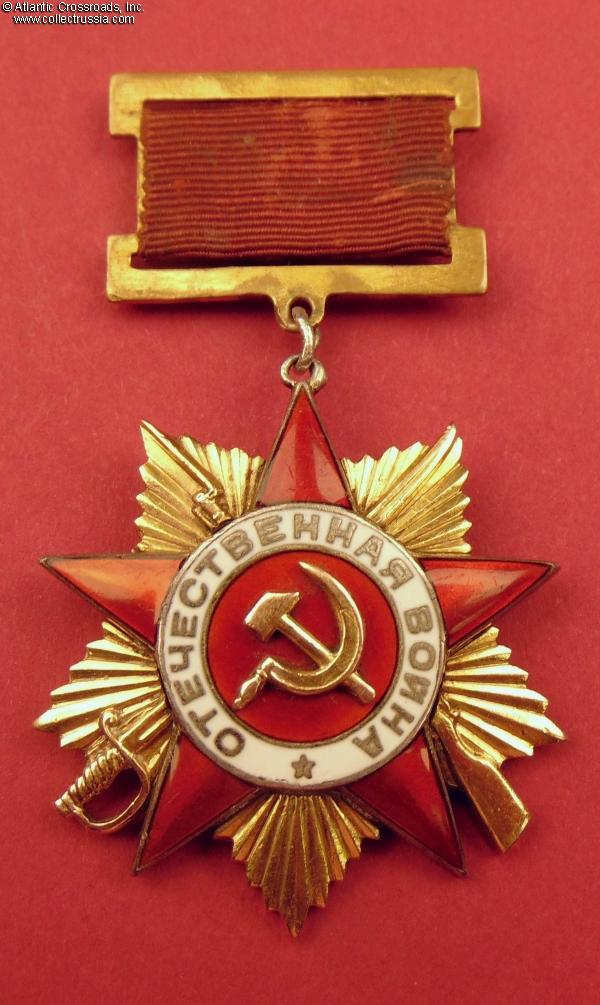
Order of the Patriotic War, 1st class, Type 1, Variation 2, #4876, awarded on 26 July 1943 to Guards Senior Lieutenant Pavel Bukharin (Павел Капитонович Бухарин), Battery Commander of the 62nd Guards Artillery Regiment, 29th Guards Rifle Division, 7th Guards Rifle Corps, 10th Guards Army, for the pursuit of the retreating Germans during their withdrawal from the Rzhev salient.
Solid gold (starburst, hammer & sickle emblem), silver, enamels. The medallion measures 46.6 mm tall (incl. eyelet), 42.2 mm wide; weighs 29.4 g not including the suspension and connecting link; overall weight with suspension and screw plate is 45.0 g. The suspension measures 32.4 mm in width, 21.3-21.4 mm in height (not including the provision for connecting link at the bottom). There is a stick pin on the reverse of the badge, the distinguishing feature of the Variation 2. The serial number is engraved in standard manner at 7 o'clock position.
In excellent condition, abs
Solid gold (starburst, hammer & sickle emblem), silver, enamels. The medallion measures 46.6 mm tall (incl. eyelet), 42.2 mm wide; weighs 29.4 g not including the suspension and connecting link; overall weight with suspension and screw plate is 45.0 g. The suspension measures 32.4 mm in width, 21.3-21.4 mm in height (not including the provision for connecting link at the bottom). There is a stick pin on the reverse of the badge, the distinguishing feature of the Variation 2. The serial number is engraved in standard manner at 7 o'clock position.
In excellent condition, absolutely extraordinary for this version of the order. Unlike the vast majority of surviving original Type 1 specimens, the enamel is perfect and has not been repaired; it is completely free of the usual chips and flaking, retains magnificent luster throughout, and has only some microscopic contact marks unnoticeable to the naked eye. The golden starburst and hammer & sickle emblem are nearly pristine, having only a few minuscule dings that are practically unnoticeable without magnification. The wires holding the hammer & sickle are intact and tight.
The stick pin is original, sound, and has not been repaired or reattached. There is a very attractive even patina to the reverse of the silver star. The order has not been converted to screw back and retains its original suspension device, complete with the retaining nut and rectangular back plate. The screw post is full length, over 12 mm measured from the back plate, and includes an original mint marked screw plate. The heavily worn but sound and attractive old ribbon is in all likelihood original as well. The connecting link appears to be original, and although deformed by the weight of the medallion, still sound; its ends are still joined with solder.
Overall, an exceptional piece. To reiterate, its condition is nothing short of superb for any Type 1, but it is virtually unheard of to find the early "Stick Pin" version so beautifully preserved.
Born in 1919 in the city of Chelyabinsk, Pavel Bukharin joined the military in 1938. In all likelihood, he chose to become a career officer in the Red Army by enrolling in a military school after the regular stint as a conscript. During the Patriotic War, he was at the front starting from September 1941 and took part in the Battle of Moscow. As of the spring of 1943, Bukharin served as commander of the reconnaissance of an artillery squadron of the 62nd Guards Artillery Regiment, 29th Guards Rifle Division, 7th Guards Rifle Corps, 10th Guards Army. In this capacity, he took part in the pursuit of the retreating German troops during their withdrawal from the Rzhev salient in March 1943. Codenamed Operation Bueffel ("Buffalo"), the retreat had been carefully planned by the German high command aiming to withdraw from an untenable position, straighten the front, and thus release forces badly needed in other areas. The Soviet pursuit in the footsteps of the retreating Wehrmacht is now referred to as the Rzhev-Vyazma Offensive of 1943 by Russian historians. It was the final chapter in the long series of exceptionally costly and mostly unsuccessful Soviet offensives in the area collectively known as the Rzhev Meat Grinder.
During the operation, Bukharin's division and its 10th Guards Army were deployed on the extreme south of the Rzhev salient. According to his subsequent recommendation for an award, Bukharin operated as a spotter for his artillery squadron throughout the offensive. His directions resulted in the destruction of an enemy earth-and-timber pillbox and two antitank guns, as well as suppression of two mortar batteries. While on a spotting mission in the area of the village of Sapanovo on 15 March, Bukharin was lightly wounded in the head but remained at his post and carried on with his assignment. On 7 July, after a significant delay, he was recommended for the Order of the Patriotic War, 2nd cl. by his regiment commander. Very uncharacteristically - at least at that stage of the war - the commander of the 7th Guards Rifle Corps then upgraded the award to the Order of the Patriotic War 1st cl., which was bestowed upon Sr. Lt. Bukharin on 26 July 1943. By the time he received his first decoration of the war, Bukharin had already been promoted to an artillery squadron commander in the same regiment.
The delay in the award recommendation could be explained by the fact that the Soviet pursuit of the Germans at Rzhev was largely a failure. Although it was trumpeted as a great achievement and a result of a hard-fought battle in the Soviet press (so much so that Stalin was even congratulated on the occasion personally by Winston Churchill), the Soviet high command knew better. In reality, the Army Group Center managed to extricate its forces from the salient with very minimal losses after blowing up all the civilian and military infrastructure in their wake, while the Soviets were slow to react. The newly available divisions from Rzhev and fresh troops moved from France nearly restored the manpower situation for the Wehrmacht on the Eastern Front to the pre-Stalingrad level, thus allowing Hitler and his generals to plan a new major offensive at Kursk. That brought about a dismissal of several Soviet generals including - albeit temporarily - the Commander of the Central Front Ivan Konev, who would later redeem himself as the Steppe Front Commander in the Battle of Kursk and the conqueror of Berlin. Thus, decorations for the final Soviet offensive at Rzhev are pretty uncommon.
Bukharin earned his second and final high decoration of WW2 a year later during the 2nd Baltic Front's offensive in northwestern Russia and Latvia which followed up on the earlier success of the Soviet Operation Bagration in Belorussia. In the opening phase of the offensive on 15 July, the 10th Guards Army forced the Velikaya River and liberated the town of Opochka, with Bukharin's division breaking through the German defensive positions in the area of Andro-Kholmy directly east of Opochka. Bukharin had made a significant contribution to the outcome of the operation by reconnoitering the German positions well ahead of time. He had detected exact positions of two artillery batteries, two mortar batteries, and eight heavy machine guns in the forward line of defense. These targets were subsequently wiped out by the artillery in the opening phase of the offensive, opening a path of advance for the division/s infantry.
On 13 July, Bukharin was cut off by the enemy while at a forward observation post. Facing a capture, he with complete contempt of death called the regiment's artillery fire upon his own position. The artillery strike scattered the enemy troops forcing them to retreat to their jumping off point. Almost miraculously, Bukharin survived this episode unscathed. On the following day, he personally eliminated a German machine gunner and captured his machine gun in a skirmish near Opochka. Putting the captured weapon to good use, he killed up to 15 more enemy soldiers in that single engagement.
On 23 July, Bukharin was recommended for the Order of the Red Banner by his regiment commander. Within a month, the award was approved by the chain of command through the Commander of the 15th Guards Rifle Corps (to which the 29th Guards Rifle Division had been re-subordinated by that time.) The award was officially bestowed upon Bukharin by a general order for the 10th Guards Army on 4 September 1944.
Bukharin ended the war with the rank of Guards Major. As of December 1946, he was still on active duty as a deputy squadron commander with the 114th Mechanized Regiment, 36th Mechanized Division stationed in Estonia.
Research Materials: photocopy of the award record card, award commendations for the Order of the Patriotic War and Order of the Red
Banner, and relevant pages of the award decrees. Information about the 29th Guards Rifle Division can be found in the Volume 4 Red
Guards of the Soviet Order of Battle in WW2 book series by Charles Sharp.
$4,600.00 Add to cart

